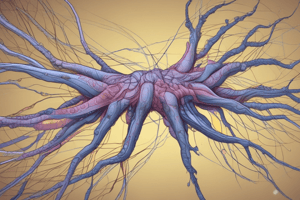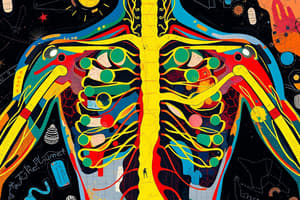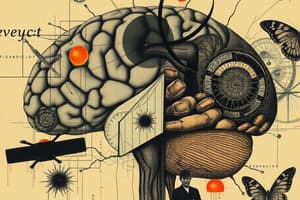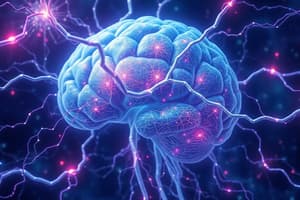Podcast
Questions and Answers
Which cranial nerve is responsible for pupil movement up and down?
Which cranial nerve is responsible for pupil movement up and down?
- Oculomotor (correct)
- Olfactory
- Accessory
- Optic
What is the primary function of efferent fibers in the central nervous system?
What is the primary function of efferent fibers in the central nervous system?
- To perform reflex actions
- To carry sensory information to the CNS
- To process information within the CNS
- To transmit impulses to muscles and glands (correct)
Which process is NOT involved in terminating the action of a neurotransmitter?
Which process is NOT involved in terminating the action of a neurotransmitter?
- Diffusion out of the synaptic cleft
- Inactivation by an enzyme
- Synthesis of new neurotransmitters (correct)
- Re-uptake into the presynaptic nerve
Which neurotransmitter is primarily associated with muscle contraction signaling?
Which neurotransmitter is primarily associated with muscle contraction signaling?
Which part of the neuron increases the surface area for receiving information?
Which part of the neuron increases the surface area for receiving information?
What role does the choroid plexus play in the central nervous system?
What role does the choroid plexus play in the central nervous system?
Which cranial nerve is involved in regulating vital functions of organs?
Which cranial nerve is involved in regulating vital functions of organs?
What is the function of the axon in a neuron?
What is the function of the axon in a neuron?
What is the primary function of the parasympathetic nervous system?
What is the primary function of the parasympathetic nervous system?
Where do the preganglionic cells of the parasympathetic system originate?
Where do the preganglionic cells of the parasympathetic system originate?
Which neurotransmitter is released by postganglionic neurons in the parasympathetic nervous system?
Which neurotransmitter is released by postganglionic neurons in the parasympathetic nervous system?
What physiological effect is NOT associated with parasympathetic activation?
What physiological effect is NOT associated with parasympathetic activation?
What distinguishes the sympathetic nervous system's neurotransmitter at the postganglionic level?
What distinguishes the sympathetic nervous system's neurotransmitter at the postganglionic level?
Which response is considered a characteristic of the sympathetic nervous system?
Which response is considered a characteristic of the sympathetic nervous system?
What impact does the parasympathetic system have on GI motility?
What impact does the parasympathetic system have on GI motility?
Hyperpolarization in neurons primarily refers to which of the following?
Hyperpolarization in neurons primarily refers to which of the following?
What medication might be prescribed to a 16-year-old male with Tourette's syndrome to manage his tics?
What medication might be prescribed to a 16-year-old male with Tourette's syndrome to manage his tics?
For a 52-year-old female with depression and anxiety following a stroke, which medication class would be most appropriate?
For a 52-year-old female with depression and anxiety following a stroke, which medication class would be most appropriate?
What should be assessed before giving medication for a patient with restless legs syndrome?
What should be assessed before giving medication for a patient with restless legs syndrome?
Which medication is best suited for preventing severe headaches in a 30-year-old male with cluster headaches?
Which medication is best suited for preventing severe headaches in a 30-year-old male with cluster headaches?
In administering memantine for nerve regeneration in a spinal cord injury patient, which nursing intervention is essential?
In administering memantine for nerve regeneration in a spinal cord injury patient, which nursing intervention is essential?
What should be included in the planning phase before administering a drug?
What should be included in the planning phase before administering a drug?
Which of the following is NOT a nursing intervention when administering CNS drugs?
Which of the following is NOT a nursing intervention when administering CNS drugs?
What drug class does ropinirole belong to for treating restless legs syndrome?
What drug class does ropinirole belong to for treating restless legs syndrome?
Which drug is used to manage chronic pain associated with diabetic neuropathy?
Which drug is used to manage chronic pain associated with diabetic neuropathy?
What medication is an antipsychotic used for treating symptoms of schizophrenia?
What medication is an antipsychotic used for treating symptoms of schizophrenia?
Which drug would be appropriate for a patient experiencing recurrent seizures due to epilepsy?
Which drug would be appropriate for a patient experiencing recurrent seizures due to epilepsy?
Which class of medication is used as a cognitive enhancer for attention deficit hyperactivity disorder (ADHD)?
Which class of medication is used as a cognitive enhancer for attention deficit hyperactivity disorder (ADHD)?
What is the role of tPA in the context of an acute ischemic stroke?
What is the role of tPA in the context of an acute ischemic stroke?
Which medication should be considered for a patient diagnosed with multiple sclerosis experiencing spasticity?
Which medication should be considered for a patient diagnosed with multiple sclerosis experiencing spasticity?
For which condition is amitriptyline commonly used?
For which condition is amitriptyline commonly used?
Which medication is indicated for alleviating motor symptoms in Parkinson's disease?
Which medication is indicated for alleviating motor symptoms in Parkinson's disease?
Which drug is used as a neuroprotective agent for amyotrophic lateral sclerosis (ALS)?
Which drug is used as a neuroprotective agent for amyotrophic lateral sclerosis (ALS)?
Which medication is used to manage depression and improve emotional well-being in PTSD?
Which medication is used to manage depression and improve emotional well-being in PTSD?
Flashcards
Central Nervous System (CNS)
Central Nervous System (CNS)
The control center of the body, composed of the brain and spinal cord.
Cranial Nerves
Cranial Nerves
12 pairs of nerves that connect the brain to various parts of the head and neck, responsible for sensory and motor functions.
Neuron
Neuron
The basic unit of the nervous system, a specialized cell that transmits information.
Parts of a Neuron
Parts of a Neuron
Signup and view all the flashcards
Afferent Fibers
Afferent Fibers
Signup and view all the flashcards
Efferent Fibers
Efferent Fibers
Signup and view all the flashcards
Synapse
Synapse
Signup and view all the flashcards
Neurotransmitters
Neurotransmitters
Signup and view all the flashcards
Parasympathetic Nervous System
Parasympathetic Nervous System
Signup and view all the flashcards
Sympathetic Nervous System
Sympathetic Nervous System
Signup and view all the flashcards
Acetylcholine (ACh)
Acetylcholine (ACh)
Signup and view all the flashcards
Norepinephrine (NE)
Norepinephrine (NE)
Signup and view all the flashcards
What are the effects of parasympathetic activation on the heart?
What are the effects of parasympathetic activation on the heart?
Signup and view all the flashcards
What are the effects of sympathetic activation on the bronchi?
What are the effects of sympathetic activation on the bronchi?
Signup and view all the flashcards
What is the role of MAO and COMT in neurotransmitter termination?
What is the role of MAO and COMT in neurotransmitter termination?
Signup and view all the flashcards
What is the role of acetylcholinesterase in neurotransmitter termination?
What is the role of acetylcholinesterase in neurotransmitter termination?
Signup and view all the flashcards
Clonidine
Clonidine
Signup and view all the flashcards
Serotonin-Norepinephrine Reuptake Inhibitors (SNRIs)
Serotonin-Norepinephrine Reuptake Inhibitors (SNRIs)
Signup and view all the flashcards
Ropinirole
Ropinirole
Signup and view all the flashcards
Verapamil
Verapamil
Signup and view all the flashcards
Memantine
Memantine
Signup and view all the flashcards
Drug Study
Drug Study
Signup and view all the flashcards
Before administering a drug, what should you assess?
Before administering a drug, what should you assess?
Signup and view all the flashcards
Patient Positioning for Drug Administration
Patient Positioning for Drug Administration
Signup and view all the flashcards
Lamotrigine for Epilepsy
Lamotrigine for Epilepsy
Signup and view all the flashcards
Interferon-beta for Multiple Sclerosis
Interferon-beta for Multiple Sclerosis
Signup and view all the flashcards
Rivastigmine for Alzheimer's Disease
Rivastigmine for Alzheimer's Disease
Signup and view all the flashcards
Ramipexole for Parkinson's Disease
Ramipexole for Parkinson's Disease
Signup and view all the flashcards
Amitriptyline for Migraines
Amitriptyline for Migraines
Signup and view all the flashcards
Pregabalin for Neuropathic Pain
Pregabalin for Neuropathic Pain
Signup and view all the flashcards
Methylphenidate for ADHD
Methylphenidate for ADHD
Signup and view all the flashcards
Sertraline for Generalized Anxiety Disorder
Sertraline for Generalized Anxiety Disorder
Signup and view all the flashcards
Primidone for Essential Tremor
Primidone for Essential Tremor
Signup and view all the flashcards
Tissue Plasminogen Activator (tPA) for Stroke
Tissue Plasminogen Activator (tPA) for Stroke
Signup and view all the flashcards
Study Notes
Drugs Affecting the Nervous System
- The central nervous system (CNS) is the body's master control unit, and the peripheral nervous system (PNS) is the body's link to the outside world.
- The spinal cord is a column of nerves connecting the brain to the peripheral nervous system.
- The brain stem connects the spinal cord to other parts of the brain and controls basic functions.
- The brain has three major parts: The forebrain (which includes the cerebrum), the midbrain, and the hindbrain (which includes the cerebellum).
- The cerebrum is responsible for higher-level functions. The cerebellum is involved in balance and coordination.
- The brain stem controls vital functions and connections.
- The autonomic nervous system regulates involuntary processes such as heart rate and digestion, operating automatically.
- The somatic nervous system carries sensory information to the CNS and relays motor commands to muscles, controlling voluntary movements.
- The sympathetic nervous system prepares the body for "fight or flight" responses to stress.
- The parasympathetic nervous system calms the body and helps conserve energy.
Nervous System Components
- The brain stem connects the spinal cord to other brain regions.
- Eight pairs of cervical nerves supply the head, neck, shoulders, arms and hands.
- Twelve thoracic nerves connect to parts of the upper abdomen and muscles in the back and chest.
- Five pairs of lumbar nerves supply the lower back and legs.
- Five pairs of sacral nerves and a pair of coccygeal nerves supply the buttocks, legs, and genitals.
Brain Divisions
-
The brain includes the cerebrum, cerebellum, and brain stem.
-
The cerebrum is divided into different lobes (frontal, temporal, parietal, and occipital).
- The frontal lobe is responsible for problem-solving, emotions, reasoning, speaking, and voluntary motor activity.
- The temporal lobe is involved in understanding language, behavior, memory, and hearing.
- The parietal lobe is responsible for knowing right from left, sensation, reading, and body orientation.
- The occipital lobe is associated with vision and color perception.
-
The brain stem controls essential functions like breathing, body temperature, digestion, and sleep/wake cycles.
-
The medulla oblongata, pons, and midbrain are parts of the brain stem.
-
The diencephalon (includes the thalamus) is a key structure.
Cerebrospinal Fluid
- Cerebrospinal fluid (CSF) is produced in the choroid plexus of the lateral, third, and fourth ventricles.
- CSF flows from the lateral ventricle into the third ventricle and then through the cerebral aqueduct into the fourth ventricle.
Limbic System
- The limbic system involves the hypothalamus (hormones and regulatory processes), amygdala (processing emotions such as fear and aggression), and hippocampus (creating and storing memories).
Reticular Activating System (RAS)
- The RAS acts as a filter, relaying important stimuli to the brain and filtering out less important or unnecessary sensory input.
- The RAS receives input from touch, pain, and temperature receptors.
Spinal Cord
- The spinal cord is a column of nervous tissue carrying signals between the spinal nerves and the brain.
- Sensory nerve roots carry sensations to the cord's rear.
- Motor nerve roots carry signals from the cord's front to control movement.
- Meninges are membranes surrounding the spinal cord.
- Ganglia contain cell bodies of sensory nerve fibers.
Cranial Nerves
- Cranial nerves are pairs of nerves that emerge directly from the brain (CNS).
- Olfactory (I), Optic (II), Oculomotor (III), Trochlear (IV), Trigeminal (V), Abducens (VI), Facial (VII), Vestibulocochlear (VIII), Glossopharyngeal (IX), Vagus (X), Accessory (XI), and Hypoglossal (XII) nerves.
Neuron Cell Structures
- A neuron has a cell body, dendrites, an axon, axon terminals, and neurotransmitters.
Neuron Types
-
Different neuron types include bipolar, unipolar, and multipolar neurons.
- A multipolar neuron has multiple dendrites and one axon.
Myelin Sheath Formation
- Schwann cells form the myelin sheath around axons.
Neuron Parts
- The cell body/soma houses the nucleus and cytoplasm.
- Dendrites are branched projections increasing the neuron surface area and receiving information from other neurons.
- The axon is the elongated part transmitting information to effector cells.
- Effector cells (muscles, glands), respond to signals from axon terminals.
- Efferent fibers transmit impulses from the CNS.
- Afferent fibers transmit impulses to the CNS.
Motor Unit Structure
- Motor units include alpha-motor neurons and muscle fibers.
Nervous System Divisions
- Peripheral Nervous System (PNS). Autonomic Nervous System (ANS). Somatic Nervous System (SNS).
- Autonomic NS is subdivided into Sympathetic and Parasympathetic components.
Nerve Synapse
- The nerve synapse is where the axon of one neuron meets another neuron.
- Vesicles release neurotransmitters into the synaptic cleft.
- These neurotransmitters bind to receptors on the receiving neuron.
Postsynaptic Cell Responses
- A postsynaptic cell (e.g., a gland or muscle) might secrete hormones, have an action potential, or contract.
Neurotransmitter Action Termination
- Neurotransmitter action ends through enzyme inactivation, diffusion out of the cleft, or re-uptake.
Common Neurotransmitters
- Acetylcholine (ACh), norepinephrine, dopamine, GABA, serotonin, glutamate, endorphins, and histamine are common neurotransmitters.
Neurotransmitter Structures
- Adrenaline, norepinephrine, dopamine, and serotonin have specific structural characteristics.
Major Neurotransmitters
- These chemicals transmit signals between nerve cells. Understanding their function and imbalances can help treat various conditions.
Nervous Pathways
- Specific pathways, such as those for dopamine and serotonin, exist in the brain. These pathways influence cognitive and emotional functions.
Autonomic Nervous System
- The autonomic nervous system (ANS) regulates involuntary bodily functions via the sympathetic and parasympathetic systems.
- The sympathetic system is activated during stress or physical activity (“fight-or-flight”).
- The parasympathetic system regulates bodily functions during rest and relaxation (“rest-and-digest”).
- The two systems often work in opposition to maintain homeostasis.
Drugs Affecting CNS/PNS
- Various drugs impact the nervous system, working on different mechanisms.
- There are groups of drugs for specific conditions (ex. Anti-epileptic agents, Anti-psychotics etc.)
Critical Thinking and Case Study Approaches
- Analyze a nervous system component (ex. a neurotransmitter) and contemplate potential issues if it's not functioning correctly, the resulting symptoms in a patient, and needed treatments.
Critical Thinking Exercises
- For a given CNS/PNS condition, brainstorm potential interventions/treatments.
Studying That Suits You
Use AI to generate personalized quizzes and flashcards to suit your learning preferences.




